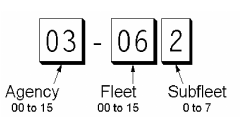
• Logical Channel Numbers – each frequency used by the
system is assigned an LCN. This information is
programmed into each user radio. When a user presses
PTT, their radio sends their AFS information to the control
channel. The computer then assigns that talkgroup to a
channel and sends the LCN so that all other radios in that
talkgroup will switch to the correct channel. To program a
EDACS system in your scanner, you will need to know both
the frequencies used by the system and the LCN for each
frequency so that you can program the frequencies in LCN
order.
• Agency-Fleet-Subfleet – talkgroup ID’s for EDACS
systems are assigned in a way that makes it easy to see at
a glance the affiliation of the user. Each radio is assigned a
2-digit agency identifier from 00 – 15. For example, 01
might be used by the police, 02 by ambulance service, 03
by the fire department, and so on. Each agency is then
subdivided up to 16 times to provide fleet identification, and
then 8 more times to identify subfleets.
For example, the complete AFS for the Police Department
West District’s dispatch channel might be 01-062. 01
identifies the agency as the police department, 06 identifies
the fleet as the West district, and 02 identifies the subfleet
as the dispatch channel. While these assignments are
somewhat arbitrary and vary from system to system, there
are many resources on the web for finding the assignments
for most systems.
Because of the logical hierarchy of the AFS system, your
BC296D lets you assign wildcard ID’s that let you, for
example, use only one ID memory to identify all units in
either an agency or a fleet.
• EDACS SCAT – EDACS SCAT (Single Channel
Autonomous Trunking) systems operate on a single channel
and alternate control data with analog voice traffic. While
your BC296D cannot track ID’s in this system, it can
eliminate the control data so that all you hear is the voice
transmissions when you monitor this type of system.
9
BC296D(NEW) 10/16/03 6:35 PM Page 9


















